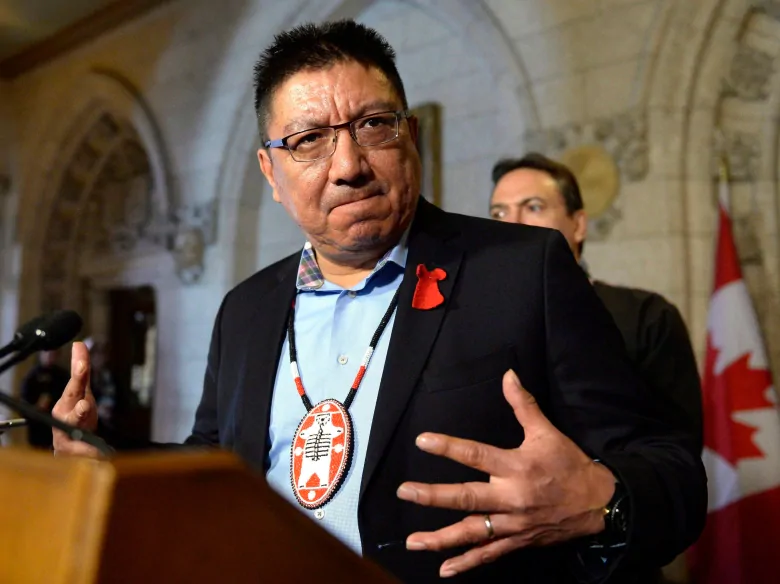Ottawa facing human rights tribunal battle over child welfare funding for remote First Nations

The federal government is facing another battle before the Canadian Human Rights Tribunal, this time over its alleged failure to account for the true cost of delivering child welfare services in remote First Nations.
Nishnawbe Aski Nation (NAN), which represents 49 northern Ontario First Nations, filed a notice of motion in October seeking a non-compliance order against Ottawa for failing to adjust its funding formula.
A tribunal decision on the motion could have national implications and require Indigenous Services Canada (ISC) to change how it determines funding for remote First Nations child welfare agencies — a change that could potentially lead to increased funding in the hundreds of millions of dollars.
NAN’s motion is supported by a report that found three northern Ontario First Nations child welfare agencies were facing funding shortfalls of up to 68 per cent because the federal government isn’t accounting for the added cost of service delivery in those remote communities.
The report, which went through three iterations, sprung initially from co-operation between ISC and NAN to solve the “persistent gap in funding for child welfare services in remote First Nations,” according to the notice of motion.
However, ISC stopped collaborating in March 2019 when the final report was filed with the tribunal, according to the notice of motion.
“Unfortunately, at the 11th hour, at the end of March, when we had agreed we would submit this report jointly to the tribunal, they backed away. I can’t really say what happened, or why it happened,” Nishnawbe Aski Nation Grand Chief Alvin Fiddler told CBC News.
“It’s not just a money issue; it impacts people’s lives on a daily basis.”
The federal government has until Feb. 13, 2020, to file responding affidavits.
“Canada hopes to resolve this disagreement without further litigation but respects NAN’s choice to pursue litigation and will respond to it respectfully and constructively,” said Leslie Michelson, spokesperson for ISC, in an emailed statement.
Michelson said the government continues to work with NAN to “develop mutually agreeable remedies for the remoteness issue.”
The human rights tribunal ruled in January 2016 that the federal government discriminated against First Nations children by underfunding child welfare services on reserves and in Yukon. NAN was given intervener status on the case in May 2016.
The federal government is currently before the Federal Court seeking to quash a compensation order from the tribunal for all children — along with some parents and grandparents — who were taken from their homes and extended families through the on-reserve child welfare system and in Yukon since 2006.
Report finds significant shortfall
Through a 2017 agreement endorsed by the tribunal between ISC and NAN, Barnes Management Group was selected to study the issue of service delivery costs facing remote First Nations. The firm’s report, filed in March 2019, found ISC’s funding formula for child welfare agencies was inadequate.
“Northern remote communities require many more resources than non-remote communities, with greater costs to provide services and greater community needs,” the report said.
Using a formula that quantified the cost of delivering services in remote areas and the unit costs of child and family services, the Barnes report concluded that the three agencies operating in NAN First Nations — Tikinagan, Payukotayno and Kunuwanimano — should get funding increases of 68 per cent, 59 per cent and 47 per cent, respectively.
“The … work we have done helps explain in numerical terms the shocking disparity between conditions in the North and conditions in the South,” said a Dec. 3 affidavit from David Barnes, of the Barnes Management Group, and Thomas Wilson, a professor and senior adviser at the University of Toronto’s Rotman Institute for International Business.
“The reality is … these communities are currently starting from a place of significant deficit.”
Tikinagan, based out of Sioux Lookout, serves 30 First Nations. Kunuwanimano is based out of Timmins and serves 11 First Nations, and Payukotayno, based in Moosonee, serves seven.
The Barnes report was reviewed, at the request of Indigenous Services Canada, by Martin Cooke, an associate professor of sociology and public health at the University of Waterloo. Martin was selected by NAN from a list provided by ISC.
Cooke said he concluded that the Barnes report led him to “have confidence in the accuracy of the models.”
The Barnes report model is currently being eyed by other First Nations organizations in Alberta, Saskatchewan and Manitoba, according to NAN filings.
‘Frustration’
ISC currently uses a formula in Ontario based on how provincial gaming funds are distributed to First Nations that adds 10 per cent for additional costs in remote communities, according to NAN filings with the tribunal.
“ISC continues to rely on this formula. It did so most recently over the late summer and spring of 2019,” Bobby Narcisse, NAN’s director of social services, said in a Dec. 3 affidavit.
In a statement to CBC, Michelson said ISC is following a Chiefs of Ontario resolution passed in April 2019 that called for the department to use the gaming revenue formula for child welfare funding.
Narcisse’s affidavit points out that NAN chiefs passed a resolution in 2017 saying the formula doesn’t work for communities in northern Ontario and that Grand Chief Fiddler had written to ISC Minister Seamus O’Regan expressing “frustration” over the department’s refusal to change.





